Two months ago, the people of my island closed their doors, went to bed and woke up to a scene which rendered Anguilla and its inhabitants pretty much speechless. The tittering of island life, both visual and auditory, depends so much on the comfort of living in a land swept by the calm tranquility of a wind bringing positivity and levity, not a dark ravaging torrent of nature. Post-Irma Anguilla was a timbre created even before the arrival of the storm. There is a strange sense of pre-mourning which sets in when preparing for a hurricane. Unlike other wind disasters, hurricanes in the Atlantic basin come with about a week’s notice during which time residents can make adjustments to their properties and pantries. In Anguilla, the news of a Category 5 storm means bracing one’s home for at least one month’s survival without basic amenities such as electricity and running water. We filled five-gallon buckets with water, running our fingers through the stream coming out of the tap knowing that it would be weeks or months before we saw it again. Candles waited patiently with fresh wicks ready and matches, secure in their cardboard beds, settled in waterproof mason jars. Cases of potable water stacked in the kitchen of my home and many others alongside armies of tinned food. Across the island, people cooked meats and fish from their freezers or seasoned them so they would keep after the power went. Families ate on their porches that evening because houses would be too hot inside with the shutters all closed. The air in a hurricane-ready home hangs with a thick foreboding presence.
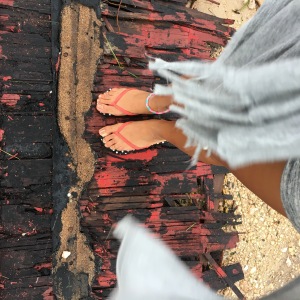
When the power went, it took with it its control. West Indians know how to live without dependence on electricity, but it doesn’t mean we don’t miss the simplicity. Immediately following the storm, when the poles lay defeated along the roadsides or leaned with fatigue on the caved roofs of people’s homes, we all knew it would be a long time before life would return to normal. This wasn’t the first time something like this had happened. Hurricane Luis in 1995 also destroyed the power lines and full electricity was not re-supplied to Anguilla for months. The difference between 1995 and 2017 is twenty-two years, several iterations of the mobile phone, and dependence on the tangled connection of the internet. Without electricity or internet, a millennial home is reduced to a startlingly unrecognizable version of the early nineties.
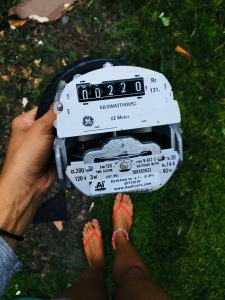
After a week or so in a sort of dazed post-hurricane limbo waiting on more Category 5 storms, people were finally able to begin rebuilding their lives and salvage what could be rescued of homes and businesses. To me, that waiting was the worst part. Every other hurricane I’ve been through resulted in a unifying call to action among the Anguillian people. We surface from our bunkered homes to help neighbours and begin repairs. Hurricane Irma was a horse of a different colour. Following on her tail was Hurricane Jose who was projected to hit us just three days later. The tone of urgency to re-secure and clear was wrought with the fear of what another storm would do to us so near to the devastation of a Category 5. The limbo period was the strangest. The population of Anguilla went from 14,000 to 14,001; its new resident was the middle portion of the Atlantic hurricane season. Hurricane Jose brought only rain and skies the colour of our spirits. Hurricane Maria visited with winds which had nothing to terrorize. There were no more leaves to blow off of any of the trees. The portion of the storm we received merely rattled already defeated galvanize and tore holes in optimistic tarpaulins. Hurricane Maria was too busy doing to Dominica what Irma had done to Anguilla.
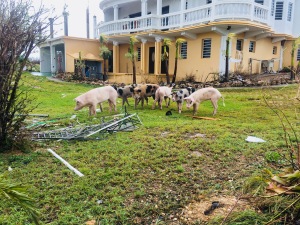
Everyone was gun shy after that, though. I recall there being a report of a tropical depression and some people were certain it would manifest into a hurricane given the behaviour of the season up to that point. If something rattled outside, we jumped. Anything stronger than the kiss of the early autumn sea breeze was a potential predatory act of nature. Days and nights melted together, a steady march of survival. There were lines everywhere. Twisted wire lines of useless telephone poles; grocery store lines where people waited for cashiers to operate internet-dependent registers with no internet; gas lines where battered cars looked like creatures in a dystopian novel, the drivers frustrated from hours of waiting for rationed fuel. Lines became the contour of the melded weeks following Irma.
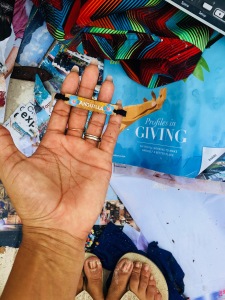
People began to unify, reach out, clean up and move forward. Anguilla’s two best assets were the first things to return to normalcy: the beaches and the people. Roy’s Bayside Grill became the new watering hole in Sandy Ground; the owners raised money to donate to damaged sectors like the primary schools. When you sat at the table on the deck of Roy’s with the twinkle lights of the sky majestically declaring their presence in lieu of a ceiling, it felt normal for a moment. The generator noise hummed along with the band and people around were laughing and smiling like they would not be returning home to dark dwellings and bucket baths. In town, businesses reopened, gas lines shrank and store shelves began to look less barren as the shipping companies frequented their routes again.
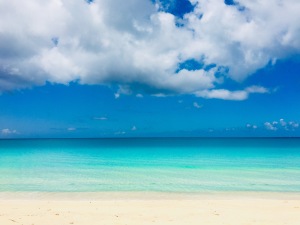
The mild wave of destitution which had risen to lap our shores in the wake of Hurricane Irma began to subside. Hope revealed itself in tentative ways; first the blossoming of yellow crocus flowers as floods subsided; then the tender unfurling of new leaves on the spiked branches stripped from the storm. Areas were re-energized, children went back to school, and people began to adjust to the new normal. The refrigerated section of my favorite grocery store started making the packaged portions of fruits and vegetables smaller so people could buy enough for one meal since many still had no fridge to put leftovers in.
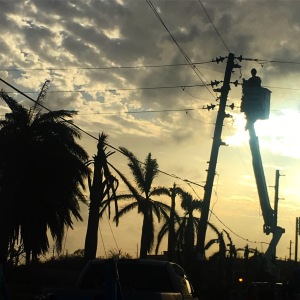
We were reconnected to the grid at my in-law’s home in Little Harbour fifty-three days after the hurricane. While we had been living in the comfort of a generator during that period, this was still a time for rejoicing. Generators are expensive as hell to maintain consistent electricity for a homestead. As such, we had taken to using it for six luxurious hours a day in order to utilize the fuel most efficiently. The feeling of urgency which was associated with electricity provision prior to the reconnection took a while to fade. We still rushed to plug everything in at six o’ clock which had previously been dubbed “generator on time” by my two-year-old nephew. With the introduction of electricity, it began to feel less like surviving and more like living. After functioning for seventy-two uninterrupted hours, the fridge started producing ice again. We bought yogurt and ice cream and drank everything with fresh ice cubes brought forth by the automated lever which had remained useless for the previous eight weeks.

If I were to really articulate it, I would tell you that surviving a Category 5 hurricane means much more than coming out of it on the other side. It means waking up each day without the pressure of matching your life activities to the amount of daylight hours or gearing up to spend a few hours in line for diesel. Surviving means going forward without the leisure of entertainment, but with the main goal of keeping things safe and running smoothly. Living means enjoying the little things your country has to offer. Spending the day on a picnic bench cabana in front of Falcon’s Nest was the first period I felt like I was living following the event which took everyone’s plans for the rest of the year and said “nope”. Living in Anguilla means so much more to me now than it did in the years before Hurricane Irma. I have seen true comradery and community spirit ranging from Blanchards Restaurant’s philanthropic endeavor to supply relief to the island to reading in this week’s paper that Sunset Homes has pledged to renovate the damaged Tender Loving Care Elderly Home.
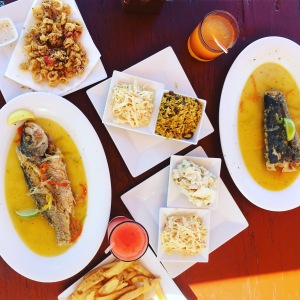
Ultimately, it is now November 2017; what would have been the start of a robust tourist season on my little island whose only industry is beaches and smiles. Now is when surviving will start to take its toll on those who would have gone back to work this month. Now is when people will start to question if they are living or just doing lines in a series of sunrises. If you ever considered taking an Anguilla vacation before, this is the time. We need you to add us to your schedule of living now more than ever.
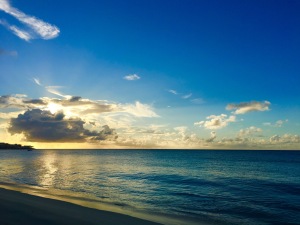
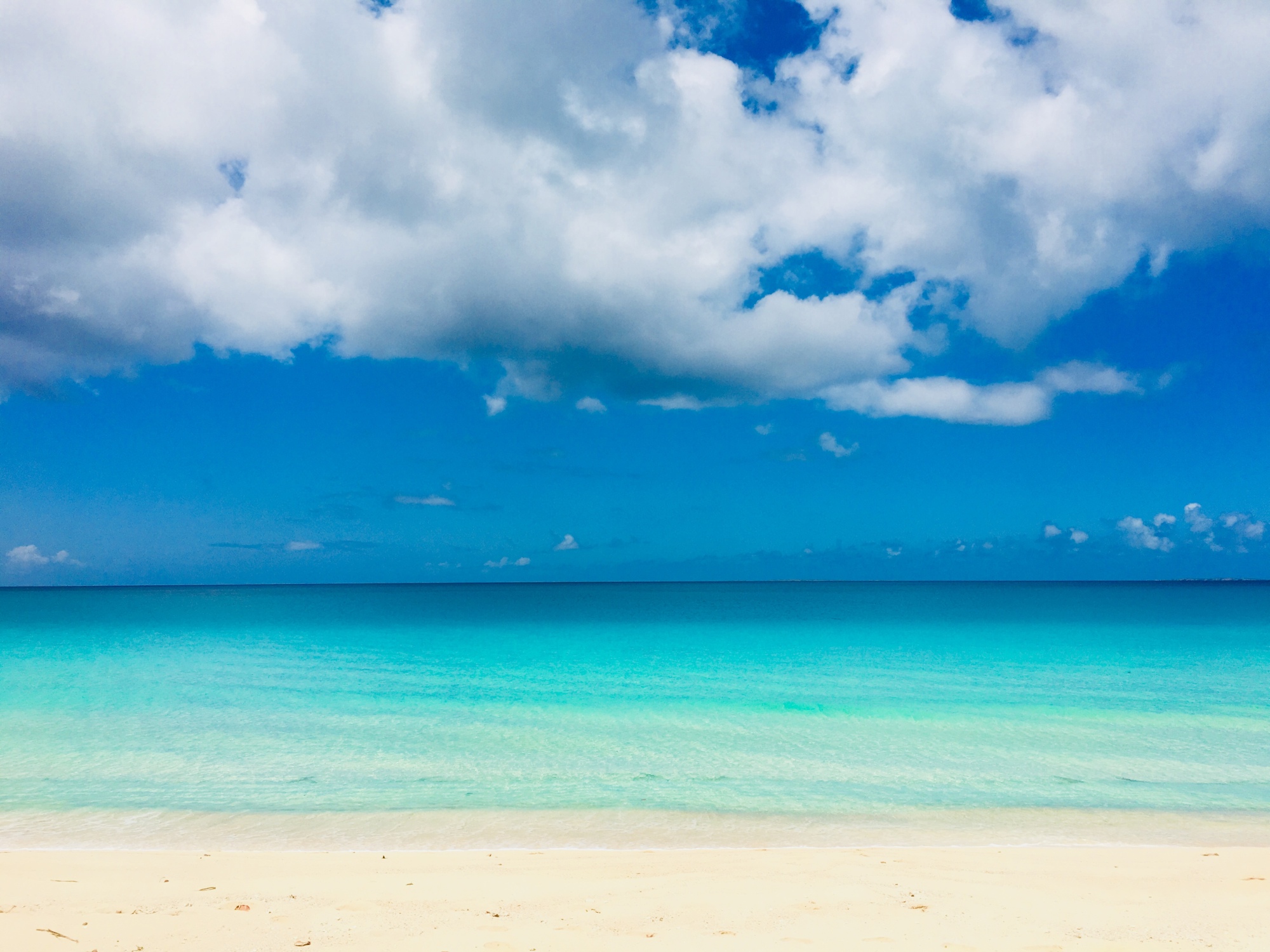
Vanessa, as usual, your writing is very moving and from the heart, thank you for taking the time.
LikeLike
Thanks so much for taking the time to read.
LikeLike
❤️
LikeLike
❤️. As it it could have been any fresher in my head. Beautifully written my love.
LikeLike
Felt as if I experienced it! Wonderfully written teach!
LikeLike
Thanks, Lan 😊
LikeLike
Beautifully written. Hope the kids enjoyed the books etc.
LikeLike
Thank you! They certainly are. I’m going to do a follow up post on the book drive soon.
LikeLike
Accurate. Beautiful. Where is the novel? 😉
LikeLike
Soon come.
LikeLike
What’s up with scilly key and it’s lovely owners?….AND…I prefer Shoal Bay for the beach 🙂
LikeLike
Scilly Cay looked okay from where I stood on Island Harbour Bay the other day. Shoal Bay is a good beach for sure! I’m partial to Meads though 😉
LikeLike
this is what makes Anguilla stand apart, why I love Anguilla, and why I will always come back! Thank you for this beautiful reaffirmation of you country’s beauty of spirit and soul.
LikeLike
One incredibly silver lining from all of this has been to connect with others outside Anguilla who love her so very much on these posts and pages. To hear their stories, see their photos, and realize there is so much more for us to see and do; and more people to meet who already feel like family, when we return, hopefully in early 2018!
LikeLike
It is the beautiful people, the most wonderful beaches and the food. All this together with the heart of the people-ANGUILLA WILL BE BACK. AND SO WILL MY FAMILY AND I.
LikeLike
Love it and can’t wait to come back.
LikeLike
Anguilla is definitely on my list ☺️🔆
LikeLike